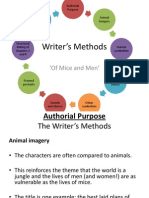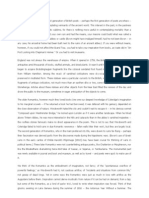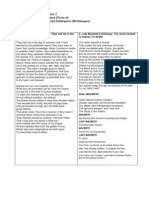0 ratings0% found this document useful (0 votes)
84 viewsH Is For Hawk
H Is For Hawk
Uploaded by
OLIUR RAHMANThe document is a summary of the memoir 'H is for Hawk' by Helen Macdonald. It details her attempts to train a goshawk named Mabel following the death of her father to help deal with her grief. The summary analyzes Macdonald's descriptive writing style and how training Mabel helped her cope with loss and regain her humanity through the companionship of the hawk.
Copyright:
© All Rights Reserved
Available Formats
Download as PDF, TXT or read online from Scribd
H Is For Hawk
H Is For Hawk
Uploaded by
OLIUR RAHMAN0 ratings0% found this document useful (0 votes)
84 views3 pagesThe document is a summary of the memoir 'H is for Hawk' by Helen Macdonald. It details her attempts to train a goshawk named Mabel following the death of her father to help deal with her grief. The summary analyzes Macdonald's descriptive writing style and how training Mabel helped her cope with loss and regain her humanity through the companionship of the hawk.
Original Title
h is for hawk
Copyright
© © All Rights Reserved
Available Formats
PDF, TXT or read online from Scribd
Share this document
Did you find this document useful?
Is this content inappropriate?
The document is a summary of the memoir 'H is for Hawk' by Helen Macdonald. It details her attempts to train a goshawk named Mabel following the death of her father to help deal with her grief. The summary analyzes Macdonald's descriptive writing style and how training Mabel helped her cope with loss and regain her humanity through the companionship of the hawk.
Copyright:
© All Rights Reserved
Available Formats
Download as PDF, TXT or read online from Scribd
Download as pdf or txt
0 ratings0% found this document useful (0 votes)
84 views3 pagesH Is For Hawk
H Is For Hawk
Uploaded by
OLIUR RAHMANThe document is a summary of the memoir 'H is for Hawk' by Helen Macdonald. It details her attempts to train a goshawk named Mabel following the death of her father to help deal with her grief. The summary analyzes Macdonald's descriptive writing style and how training Mabel helped her cope with loss and regain her humanity through the companionship of the hawk.
Copyright:
© All Rights Reserved
Available Formats
Download as PDF, TXT or read online from Scribd
Download as pdf or txt
You are on page 1of 3
H is for Hawk
Grief as hard as it is to express, more so to experience, leads to deterioriation of one’s
mental health and self-destruction, especially when it comes to coping and acceptance.
H Is for Hawk (2014) is British author Helen MacDonald’s award-winning memoir about
her attempts to train a goshawk named Mabel in the wake of her father’s death. It is a
memoir of grief, self-discovery, and the healing power of nature. It is a story of a woman
regaining her humanity through the companionship of a beautiful flying animal.
Following the death of her father, Macdonald retreats to the comfort of the wild; decides
to tame a hawk to relieve herself from sorrow and “lost,” depicting the author’s sufferings
from grief.
While H is for Hawk is a non-fiction text, much of the language in it is descriptive and
lyrical, straying closer to language we may expect to find in a novel instead. This holds
particularly true when Macdonald is writing about Mabel and nature more broadly, “later
that afternoon I take Mabel into the walled garden... Above us is a deep field of fast-
moving cumulus.”
The author’s detailed descriptions of nature frequently to showcase its beauty and power,
“Branches lift in the breeze; leaves shift with a collapsing, papery flicker. The air is thick
with sun and dust and dandelion seeds. There's too much light, too much contrast,”
somehow portrays that in a time in her grieving process, nature and Mabel are all
Macdonald has. They isolate themself and focus on nature instead of anything else in
their broader life. The extract specifically relays the tension-filled scenes she experiences
in meeting the Goshawk she later tames, and the stunned realization that the specie
whom she gets attached to is not really hers.
“Don’t want you going home with the wrong bird.” A foreshadow of the irony that the
cautionary words bring entails suspicion in the mind of the reader, considering that the
author is a very experienced and enthusiastic falconer, as she uses direct speech in the
first line “We’ll check the ring numbers against the Article 10s,” that gives a feeling of
excitement and sense of urgency.
The simple word choices vividly convey the visuals of the boxes where the bird is kept.
The onomatopeia in “ A sudden thump of feathered shoulders and the box shook as if
something had punched it!” creates tension and encourages concern and simultaneously
connoting violence and power. The italicisation of “thump” somehow communicates the
forceful and violent nature of the bird, comparing the sound of the box in simile of a bird
trying to escape and doesn’t like being caged, contributing to a sense of foreboding and
dread to the danger forecasted to the nature of what’s inside the box. The short sentence,
“Like us,” in the last line of this paragraph emphasizes the fact the sight of humans might
scare the hawk.
Succeedingly, the author’s weild of short and series of incomplete sentences delivers a
feeling of pace, tension and potential danger with “Another hinge untied.
Concentration.Infinite caution...” Repeteadly mentioning “another” and “thump” increases
tension and anticipation of her feelings toward seeing the bird with the words “The last
few seconds before a battle.”
Macdonald’s list and description of sounds, “...and amidst a whirring, chaotic clatter of
wings and feet and talons and a high pitched twittering...” attribute to the noisy and chaotic
nature of the bird in jumbled succession to the author’s portrayal of the hawk. Aside from
Helen’s illustration of the hawk, she reveals her feelings at the beginning the third
paragraph, the repetition of the conjunction “and” speeds up the pace, showing a large
number of details the writer notices, implying that she was worried, though
disconcerted,she is quite interested and paid a great amount of attention to the hawk.
Subsequenstly, the repetition of “enormous” conveys the author’s surprise at the size of
the hawk, and the sudden switch to present tense is a direct approach to the reader to
make them feel that the events are happening now. The alliteration in “the hawk’s wings,
bared and beating...” gives the impression of rhythmic movement and sound of the bird’s
wings, while “beating” alludes to one’s heartbeat or a drumbeat—an inkling to rhythm and
fierceness.
The writer’s use of metaphor and list of proper nouns convey the majestic nature of the
hawk, “she is a conjuring trick. A reptile. A fallen angel. A griffon from the pages of an
illuminated bestiary,” clearly displays her attachment to the young hawk that represents
fierceness, outstanding beauty and innocence—a vivid illustration of her admiration to its
magnificence and unbounded courage.
The bird’s jagged feathers are compared to the spikes of a porcupine when the author
uses simile to describe “her feathers raised like a scattered quills of a fretful porcupine,”
signifying that the hawk is fluffed up, tyring to make itself look bigger, noting that
porcupines rain and rattle their quills to defend against an enemy, which drafts to the
reader’s mind that the hawk is scared of the humans and wants to protect itself.
Notably Macdonald’s start with a conjunction in a sentence that spans five lines "but now
it this; she can see everything..." portrays the hawk’s point of view. It depicts how amazing
the bird’s eyesight is and how much it loves freedom. Beginning with “but” and the long
sentence create a contrast between the small places the hawk previously lived in and the
huge world the hawk can see now.
From the strange and magical madness of the hawk's first release to something more
tender and even maternal instinct, reflects the author’s change in writing style when she
describes the calmness of the man handling the hawk in perfect movement, “there was
concern in his face. It was born of care." "All at once, i loved this man and fiercely." The
adverb “fiercely” manifests how fascinated she is to the man’s care for the bird. It is to be
remembered that the writer recently lost her father and is getting the hawk to find comfort
and friendship through her grief.
Learning as a child from her father that tolerance is essential, especially on birds, Helen
realizes her father’s words when she learns that the the bird is not the one meant for her.
“Oh,” this use of a single word emphasises her disappointment and sadness. As they “put
it back and opened the other box...” “...dear God” displays animosity that the writer feels
with the seond and larger hawk, utilizing direct speech, the author imparts the strange
feeling that it somehow does not belong to her. "She came out like a Victorian Melodrama:
a sort of madwoman in the attack," exhibits that the bird is experiencing intense and
frightening emotions.
The metaphor of the madwoman attacking creates a vivid picture in the readers mind of
a vicious female bird who is not only insane but actively wants to hurt others.
The “blank and crazy stare” finally brought the author to her senses, and admittedly with
slow panic, “I didn’t recognise her.” This isn’t my hawk...” “But this isn’t my hawk,” the
constant repetition of the author’s alienation towards the second bird emphasizes her
distant feelings.
After which, Helen’s "crazy barrage of incoherent appeals," wherein the emotive word
barrage is a military term meaning under constant attack, indicates how strongly the writer
appeals to the man for him to swap the birds. She creates reason after reason (a barrage
of reasons) and this shows the reader just how desperate she is and in turn builds
empathy for her with the reader.
"...with wind wrecked hair and exhausted eyes", the alliteration of w and then e
demonstrates to the reader how tired and bedraggled the writer is and how desperately
she is trying to get the other bird which she connected with. The description is engaging
and sympathetic. It also makes her seem a little like the birds. Tired, fearful, ruffled and
not looking her best but also dependant on the man for the answer she needs. Much like
the birds have depended on him for food and water and care. Awkward it may seem, the
fearful behavior reminds the author of herself venuring through dealing with the loss of
her father.
The author’s “pleading...as if she were in a seaside production of Medea," an allusion to
a Greek tragedy seemingly gives an ounce that she is losing control, engenders sympathy
and compassion from the reader.
A cliff hanger ending in “a moment of total silence,” depicts an open end, wherein the
reader cannot anticipate whether the man agrees or not, is an inclination of circular
emotions amid the author’s anguish, notwithstanding, the pain that does not leave
regardless of one’s desire to escape from it.
Grief or pain is constant in everyone’s life. H is for Hawk brings up how lamenting the
process is. H is for hawk resembles life, brimming with its rise and fall, sufferings and
hope.
You might also like
- H Is For Hawk by Helen MacdonaldDocument3 pagesH Is For Hawk by Helen Macdonaldomondi kennethNo ratings yet
- Othello Act 3 SummaryDocument5 pagesOthello Act 3 SummaryCharvi MishraNo ratings yet
- Writer's Methods - 'Of Mice and Men'Document22 pagesWriter's Methods - 'Of Mice and Men'kabraddersNo ratings yet
- In Poem For My Sister', How Does The Poet Present The Speakers Feelings About Her Sister?Document1 pageIn Poem For My Sister', How Does The Poet Present The Speakers Feelings About Her Sister?WitchingDread10No ratings yet
- Extract Question of Mice and MenDocument1 pageExtract Question of Mice and Menpierrette1No ratings yet
- Extended Murder of Roger AckroydDocument11 pagesExtended Murder of Roger AckroydNihar KaratiNo ratings yet
- Stormcock and ElderDocument2 pagesStormcock and ElderBhai Kabir singh100% (10)
- The Open WindowDocument4 pagesThe Open Windowapi-260205329100% (1)
- The Sign of The Four Revision GuideDocument28 pagesThe Sign of The Four Revision GuidejosephNo ratings yet
- Between A Rock and A Hard Place 2024Document5 pagesBetween A Rock and A Hard Place 2024imanharunanyNo ratings yet
- H Is For HawkDocument16 pagesH Is For HawkK ActiveNo ratings yet
- My Last Duchess Revision NotesDocument11 pagesMy Last Duchess Revision NotesziggerastikkaNo ratings yet
- 'Explorers or Boys Messing About..' AnalysisDocument2 pages'Explorers or Boys Messing About..' AnalysissophiaNo ratings yet
- Edgar Allan Poe Include The Pervasive Theme of Death and DecayDocument5 pagesEdgar Allan Poe Include The Pervasive Theme of Death and Decayabekhti2008100% (1)
- Hurricane Hits EnglandDocument15 pagesHurricane Hits Englandtattie-bogle362No ratings yet
- Shelley OzimandiasDocument14 pagesShelley OzimandiasAmela Hrasnica100% (1)
- "Pass On," Michael LeeDocument5 pages"Pass On," Michael LeeAlex FloresNo ratings yet
- Raven Queens Story - Shannon HaleDocument12 pagesRaven Queens Story - Shannon Haledazaryhn808No ratings yet
- Revision Booklet: Jekyll & HydeDocument31 pagesRevision Booklet: Jekyll & HydeKa ZheNo ratings yet
- RebeccaDocument334 pagesRebeccaeclipse541No ratings yet
- Dracula Quote BankDocument10 pagesDracula Quote BankAnnabel TillyerNo ratings yet
- H Is For HawkDocument3 pagesH Is For HawkLenora Lionheart100% (1)
- Analysis of The Buck in The SnowDocument1 pageAnalysis of The Buck in The SnowNETAJI RAO0% (1)
- I Wanna Be Yours - John Cooper ClarkeDocument15 pagesI Wanna Be Yours - John Cooper ClarkeНеллиNo ratings yet
- X.1 Dracula Study GuideDocument27 pagesX.1 Dracula Study GuideBelinda XianNo ratings yet
- Metaphor of Thought Fox NisanSAhil PDFDocument2 pagesMetaphor of Thought Fox NisanSAhil PDFMd Imtiaj IslamNo ratings yet
- A-Christmas-Carol - Stave - 3Document3 pagesA-Christmas-Carol - Stave - 3HarunaNo ratings yet
- The Prelude VS KamikazeDocument4 pagesThe Prelude VS KamikazeSara100% (1)
- LaBudaCJ-TheVeldt Lesson Plan 7th GradeDocument9 pagesLaBudaCJ-TheVeldt Lesson Plan 7th Gradecarolynls55No ratings yet
- Shakespeare Makes The Playoffs Chapter SamplerDocument11 pagesShakespeare Makes The Playoffs Chapter SamplerCandlewick Press0% (1)
- Omam and AicDocument8 pagesOmam and AicDuaa Saqri RamahiNo ratings yet
- The Woman in Black Revision Session1Document82 pagesThe Woman in Black Revision Session1민정100% (1)
- Io Extract - The AwakeningDocument1 pageIo Extract - The Awakeningapi-462898738No ratings yet
- SN 3.1 Literary DevicesDocument3 pagesSN 3.1 Literary DevicesHeleina De GuzmanNo ratings yet
- Humpty Dumpty Explains JabberwockyDocument3 pagesHumpty Dumpty Explains JabberwockyjikoljiNo ratings yet
- Hunting Snake: (Judith Wright)Document4 pagesHunting Snake: (Judith Wright)Radwa EssamNo ratings yet
- Essay HarwoodDocument2 pagesEssay HarwoodMATTHEW TANG0% (1)
- Wuthering Heights Plot SummaryDocument8 pagesWuthering Heights Plot SummaryBlood Heart <3No ratings yet
- Plot Parts of The Most Dangerous GameDocument3 pagesPlot Parts of The Most Dangerous GameMs Ross100% (2)
- Hunting SnakeDocument4 pagesHunting SnakenatalieNo ratings yet
- Kaleidoscope PreviewDocument3 pagesKaleidoscope PreviewNatalia Carolina CifuentesNo ratings yet
- IOC The Road and Handmaid's Tale (Hotaru)Document5 pagesIOC The Road and Handmaid's Tale (Hotaru)HotaruNo ratings yet
- Boys 20messing 20about 20 - 20meDocument2 pagesBoys 20messing 20about 20 - 20meapi-298120057No ratings yet
- Personal Helicon LitChartDocument18 pagesPersonal Helicon LitCharth1110715No ratings yet
- The Clod and The PebbleDocument1 pageThe Clod and The PebbleNicolas100% (1)
- Suspense Literary DevicesDocument3 pagesSuspense Literary Devicesapi-357397358100% (1)
- Love and Relationships PoetryDocument57 pagesLove and Relationships PoetryMary Ann MaherNo ratings yet
- Atonement Part Three NotesDocument2 pagesAtonement Part Three NotesJennifer PolidanoNo ratings yet
- English Poems Revision ArchishasDocument16 pagesEnglish Poems Revision ArchishasEmre OzerNo ratings yet
- War of The Worlds-NovelDocument2 pagesWar of The Worlds-NovelSazzad Sohan100% (1)
- TheWashwoman PDFDocument4 pagesTheWashwoman PDFEliana Feingold100% (1)
- How Significant Is The Relationship Between Miss Maudie and The Children in The Novel As A WholeDocument3 pagesHow Significant Is The Relationship Between Miss Maudie and The Children in The Novel As A WholecallummanceNo ratings yet
- Storyteller Answer. 1Document2 pagesStoryteller Answer. 1minecrafterpro2300No ratings yet
- S2T3 - PIP Annex C - Full Text of SoliloquiesDocument3 pagesS2T3 - PIP Annex C - Full Text of SoliloquiesYeo Zhi Long100% (1)
- The Analysis Essay of "The Veldt" - Moral Approach by Atifah KhoiriyahDocument6 pagesThe Analysis Essay of "The Veldt" - Moral Approach by Atifah Khoiriyahatifahk studentNo ratings yet
- Othello Play SummaryDocument7 pagesOthello Play SummaryjawiNANANo ratings yet
- To A Daughter Leaving Home Guided AnnotationDocument2 pagesTo A Daughter Leaving Home Guided AnnotationMarcus WrightNo ratings yet
- Chapter 1 - How Nobody Came To The GraveyardDocument9 pagesChapter 1 - How Nobody Came To The GraveyardRenel ChinNo ratings yet



























































